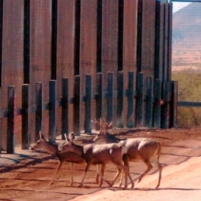Border Fence is Good for the Environment: Leo Banks
Wednesday, October 06, 2010

Environmental groups like the Sierra Club might want to take a second look at the use of fences and barriers along the border between the U.S. and Mexico, writes journalist Leo Banks. The Sierra Club has been opposed to border fences, but the use of them in Arizona demonstrates how the barriers can be beneficial to desert ecosystems.
Without structures in place to prevent smugglers from crossing into Arizona, the fragile deserts were subject to trampling by immigrants and vehicles. But now things have changed since parts of the border are fenced off.
“The smugglers have a much harder time driving their loads in and that has benefited the land,” Keith Graves, a former district ranger for the Coronado National Forest, told Banks. “We’re not seeing the kind of damage we used to see.”
Similar results have been observed in the 330,000-acre Organ Pipe Cactus National Monument southwest of Tucson, writes Banks, and in the 118,000-acre Buenos Aires National Wildlife Refuge, where vehicle barriers have kept smugglers out and resulted in fewer abandoned vehicles littering the desert.
However, environmentalists are still concerned about pedestrian fencing, which creates an impassable wall and interferes with animal migrations. In 2005, President George W. Bush signed into law the Real ID Act, which allows the Secretary of Homeland Security to ignore national environmental laws if they interfere with border barriers or fences.
-Noel Brinkerhoff
Border Fence Benefits the Environment (by Leo Banks, Daily Caller)
- Top Stories
- Unusual News
- Where is the Money Going?
- Controversies
- U.S. and the World
- Appointments and Resignations
- Latest News
- Musk and Trump Fire Members of Congress
- Trump Calls for Violent Street Demonstrations Against Himself
- Trump Changes Name of Republican Party
- The 2024 Election By the Numbers
- Bashar al-Assad—The Fall of a Rabid AntiSemite






Comments